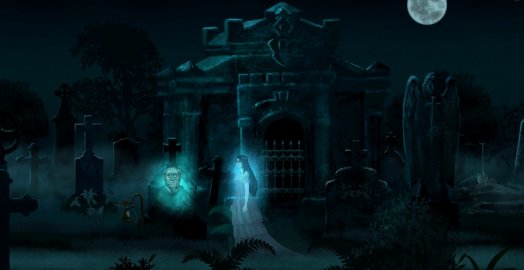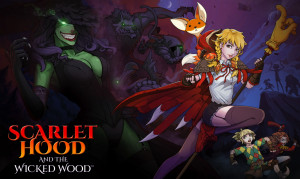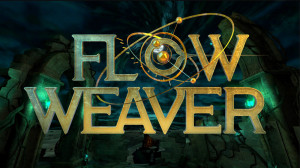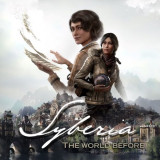Review for Detective from the Crypt

A pale moon glows down on a decrepit cemetery. Warm candlelight flickers and sparks. Lushly appointed bedchambers, a hidden laboratory, and a private museum lay abandoned in the posh family mansion. Through all this wanders the ghost of a girl who can’t remember her last day of life. BOV’s point-and-click supernatural mystery Detective from the Crypt presents a vividly illustrated Victorian estate for her to explore in search of answers to what happened to her, so it’s a shame that the rich environmental detail is largely the only thing bolstering a lack of characterization, unremarkable puzzles, and a weak ending.
Jane Darkday arises in the family crypt on the first day of her afterlife. With no recollection of how she died, she is doomed to walk the earth as a restless spirit unless she can piece together the events that occurred at the Darkday residence – tragic events that involved other occupants of the manor as well, including Jane’s own deceased parents lying in coffins next to hers. With little else to go on, the young protagonist is set loose with only a note from her dearly departed great-grandmother to find a certain Pulkheria, who apparently knows a lot and can help.
Pulkheria, it turns out, is a long-dead cat buried beneath a nearby monument. One of Jane’s first tasks is to find a way to awaken the feline’s spirit, after which Pulkheria is available to accompany Jane on the rest of her journey. The cat is able to talk, but she doesn’t have any narrative conversations with Jane. Instead, she only serves the purpose of a hint system, and dubiously so at that.
Using any of the game’s many inventory items on Pulkheria will elicit a general hint as to how it might be employed. Clicking on her directly will prompt her to comment on the current location, either offering a clue as to what Jane should be looking at or else stating, “You’ve examined everything in here. You need to look elsewhere.” The first half of this statement is indeed true whenever it appears, indicating that all hotspots have been discovered. However, the latter portion is not always accurate, as there may yet be actions still to be done there.
More reliable is Jane’s journal, which has a “Tasks” page showing what she needs to do and what she’s already done. As new tasks are discovered they’re added to the list, then later crossed off when completed. Almost every objective consists of finding an inventory item in one location and using it in another. Some involve collecting and analyzing evidence related to the central mystery, but too many chores are simple fetch quests that contribute nothing to the story. It’s certainly nice to have the list as a reminder of what needs to be accomplished, but the goals themselves often seem irrelevant. They feel more like things to do for the sake of doing something.
Much of your time is spent helping various other ghosts encountered within the cemetery or inside the mansion. There’s an inventor referred to as a “loser” who needs some good luck because people keep tripping over his grave. Then there’s an old lady looking for a way to drive crows away so songbirds will return and sing on her gravestone. A giant, multi-armed, chained skeletal spirit threatens that something generically “bad” will happen to Jane if she doesn’t bestow it with treasure in short order. Jane’s parents aren’t among these lingering spectres, so there’s no opportunity for re-establishing her familial relationships – although that’s something of a moot point as all characterizations are as insubstantial as their ghostly forms. The only thing we even really learn about Jane herself is that she likes gothic horror stories, and that’s only because she’s noted it in her journal.
Fortunately, some puzzles are a bit more interesting and require a little additional thought, though none of them are particularly taxing. The most complex involve examining evidence using a hidden laboratory that would do Doctor Frankenstein proud with its collection of period-appropriate scientific apparatus. These examinations are conducted in close-ups where things like soil samples, sugar, and coffee can be mixed with reagents to test for poison. Or hairs can be placed under a microscope and brought into focus to see if they match one another. When anything is discovered that counts as evidence, a brief note of it is recorded in Jane’s journal.
The journal also has a “Notes” tab for a handful of general points about the mystery and a “Files” tab, which lists the people involved in the events that took place on Jane’s final day. It soon becomes apparent that foul play was committed by at least one of the household residents, as evidenced by items such as “Daddy could have shot a pistol” or “Aunt had an opportunity to add poison into the sugar” appearing on the journal pages as Jane conducts her investigation. She doesn’t really comment on the accumulation of this circumstantial evidence, however, leaving it to players to review and interpret it – or not. As there’s nothing to be done with this information until the very end of the game and it’s always couched in maybes, I quickly lost interest in it. The ultimate goal is to accumulate all these factoids about Lord and Lady Darkday, Jane’s aunt, the governess, the butler, and the missing artist and poacher and then see which character has the most such tidbits logged against them. Over the course of my three and a half hours of playtime, I felt more like I was doing a bunch of busywork than piecing the mystery together.
Despite a lack of any real influence over the investigation, it is ultimately up to you to make the final determination. When wrapping up the case, Jane has the ability to watch different possible versions of events. Either through the journal or by opening a portrait of the family via a button at the top of the screen, it’s possible to pick from one of five suspects. A cutscene is then shown depicting Jane’s suppositions about the selected character and how she believes things played out on the fateful day. After watching one of these, the game displays a dialog box asking if it has shown the real sequence of events or not. Correctly choosing the culprit launches the “good” ending, while mistakenly choosing the opposite for that person elicits the “bad” ending. Unfortunately, the good ending uses one of the worst resolution tropes in all of fiction and really makes the whole exercise of playing the game feel rather pointless. I found the bad ending, which has a couple of slight variations depending on the suspect in question, to be much more satisfying, even though it leaves Jane worse off. After viewing a bad ending, the game presents a dialog box allowing you to continue from before the choice was made, either to choose the opposite verdict for the current potential culprit, or to accuse a different suspect.
The highlight of Detective from the Crypt is its art; this is a beautifully illustrated game. While only having the single estate to work with, a lot of variety is crammed into its confines. Each family member has their own distinctively appointed room in the manor, made even more unique via the clever use of wallpaper and lighting. The laboratory feels retro-futuristic with its phonograph, microscope, and test tubes, and there’s a well-stocked kitchen and wine cellar. There’s even a hall of ancient Egyptian artifacts, because what Victorian manor would be complete without one? Outside, the cemetery and crypts are bathed in the cool blue light of the moon, which grants them a somber mood.
Everything is rendered crisp and crystal clear, though the impressive level of detail means that trawling each room with the cursor to see what’s interactive still needs to be employed as it’s not always easy to tell at a glance what elements might be important. For example, one room has several displays of pinned insects. One particular bug within one particular display needs to be found, while all the others are non-interactive. This pixel hunting impact is only a slight downside to the otherwise fantastic sets, however.
Character designs are lovely as well. Most of the main players aren’t seen until the final re-enactments, though the butler, governess, and Jane’s aunt remain in the house. (As a ghost, you can’t interact with them, though you can cause the butler quite a fright.) The upper-class members of the Darkday household are all resplendently dressed in tailored suits and plush frocks, while the servants wear plainer and more muted clothing. Other secondary ghosts appear from time to time and have the same cool translucency and ethereal glow as Jane and Pulkheria.
All of the NPCs fit nicely into their respective environments until, sadly, they need to animate. While basic walking motions are fine, the game employs a paper doll style of animation where fixed limbs pivot on the appropriate joints but lack the elasticity needed to make them feel truly alive (or at least undead). Nowhere is this more apparent than when watching the various potential versions of the crimes. In one scene a character is shot with a gun, but instead of crumpling to the ground in a natural way, the sprite is simply rotated ninety degrees as if standing sideways on the floor. So unexpected was this that I found myself laughing at what should have been a moment of high tension and drama. Another sequence shows someone being sucked into a bog, arms waving about like a wind-up doll, to equally unintentionally comic effect. At least the amount of character animation throughout is low, so these immersion-breaking moments are quite rare.
While the animations may break the atmosphere, the music helps build it back up. The melancholy classical-sounding loops, which change according to location, fit the overall mood well. The wail of a poor bagpipe player is just grating enough to get the point across without being truly earsplitting. Sound effects are fairly sparse but are suitably convincing when employed, like the clank of animated suits of armour filling the main hall when Jane encounters two restless souls. The one glaring omission is voice acting, with all dialog displayed as text at the bottom of the screen.
Detective from the Crypt is pure point-and-click, but there are a few oddities in the interface that take some getting used to. The inventory is accessible as an overlay by clicking a button at the top of the screen. While items can’t be used on each other, they can be selected for use in the environment, causing the cursor to change into them. Pretty standard, and all well and good. However, if you open the inventory, which fills the top third of the screen, and don’t select an item, you have to specifically click a close button to dismiss the overlay panel instead of simply clicking in the scene or even sliding the cursor away from it.
Curiously, the inventory is the only overlay that prevents interacting with the rest of the screen. When in the laboratory performing a close-up examination, the clicks that make the apparatus work also bleed through into the room behind, causing Jane to move around. This happens with several of the game’s text windows as well, such as the manual save menu. Several times when saving, I inadvertently changed rooms as the spot I clicked coincided with a door in the underlying room. On the plus side, I was really excited to have a game with a properly implemented save system allowing both manual saves and sporting a progressive autosave. The best of both worlds!
In addition to icons for accessing the inventory and save menus, several other specialty options become available at the top of the screen. Early on, Jane recovers a magic candle that glows red when near a secret passage or a hidden treasure. Two buttons are present to allow Jane to walk around with or without the candle, but as she can freely interact with hotspots in either case, there’s really no reason not to keep it on at all times. Conversely, a single button is available for turning Pulkheria on and off once you’ve met her, in case you don’t want her tagging along all the time in between hints.
One additional icon of note is for a mirror Jane will find once she makes her way from the cemetery into the main manor chambers. Ghosts can use mirrors to move instantly from one place to another, and the manor has a secret hall lined with mirrors leading to different major areas of the estate. Jane can use any fixed mirror she encounters to transport to this hidden hall, but once she finds the portable mirror, she can use it to travel there directly from wherever she is. As there are a lot of rooms to search, and the majority of them scroll quite a ways when traversing them, this fast-travel system was definitely welcome!
While spooky in appearance, Jane’s adventure as the Detective from the Crypt ends up being rather mundane and a little dull. Her ghostly travails too often feel more like completing a weekend list of chores than digging into the sordid mysteries that seem to abound on the Darkday estate. Fortunately, the game boasts some excellent visuals that help prop up its weaker aspects. With its lovely aesthetic and melancholy atmosphere, it’s a decent enough way to while away the hours of a rainy afternoon, but like its well-rendered spirits, the experience is ultimately more about style than substance.

























__small.jpg)




